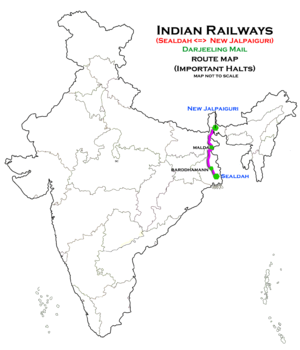New Jalpaiguri–Howrah Shatabdi Express
 HWH–NJP Shatabdi Express running through at Pakur | |||||
| Overview | |||||
|---|---|---|---|---|---|
| Service type | Shatabdi Express | ||||
| Status | Operating | ||||
| Locale | West Bengal, Jharkhand and Bihar | ||||
| First service | July 12, 2012 | ||||
| Current operator(s) | North East Frontier Railway | ||||
| Route | |||||
| Start | Howrah (Kolkata) (HWH) | ||||
| Stops | 5 | ||||
| End | New Jalpaiguri (Siliguri) (NJP) | ||||
| Distance travelled | 566 km (352 mi) | ||||
| Average journey time | 8 hrs 5 mins | ||||
| Service frequency | Except Sunday | ||||
| Train number(s) | 12041/12042 | ||||
| On-board services | |||||
| Class(es) | Executive Chair Car, AC Chair Car | ||||
| Seating arrangements | Available | ||||
| Catering facilities | Yes | ||||
| Observation facilities | LHB coaches | ||||
| Baggage facilities | Overhead racks | ||||
| Technical | |||||
| Rolling stock | LHB coaches | ||||
| Track gauge | 1,676 mm (5 ft 6 in) | ||||
| Operating speed | 71 km/h (44 mph) 130 kmph maximum permissible between Howrah and Khana | ||||
| |||||
The Howrah–New Jalpaiguri Shatabdi Express is a Shatabdi class train of Indian Railways connecting Kolkata and Siliguri, West Bengal's two important cities. It is the fastest train in the Howrah – New Jalpaiguri section covering a distance of 566 km in a span of about 8 hours.[1]

Overview[]
West Bengal chief minister Mamata Banerjee and the then railway minister Mukul Roy flagged it off from New Jalpaiguri Junction railway station on 12 July 2012, though this train was passed in Railway Budget 2012–13 by the then Railway Minister Dinesh Trivedi.[2] The train carried nine AC Chair Cars and one AC Executive Chair Car. The train belongs to the Northeast Frontier Railway zone of Indian Railways.[3]
Before the electrification of Jalpaiguri-Howrah stretch, this Shatabdi Express was the fastest Diesel Locomotive hauled train of Indian Railways having its diesel link of class WDP-4, WDP-4B or WDP-4D provided by Siliguri Junction (SGUJ) DLS. On 10 January 2020 the traction of the train was changed to electric and the regular link was changed to class WAP-7 of Howrah Junction (HWH) ELS.
Amenities[]
This train has LHB coaches, providing reclining seats, on-board meals are available and are included in the ticket fare. On 10 March 2018, it was upgraded to the Swarna Standards of Indian Railways.[4]
Route & halts[]
The intermediate stations and the stoppage time are as follows-
- Howrah (Starts)
- Bolpur Shantiniketan (2 minutes)
- New Farakka (1 minute)
- Malda Town (5 minutes)
- Barsoi (1 minute)
- Kishanganj (2 minutes)
- New Jalpaiguri (Ends)
Speed[]
Its all coaches are of air conditioned LHB coaches type which is capable of reaching 160 kmph but it does not touch. Sometimes people become confused because according to Indian Railways Permanent Way Manual (IRPWM) on Indian Railways website or Indian Railway Institute of Civil Engineering website, the BG (Broad Gauge) lines have been classified into six groups ‘A’ to ‘E’ on the basis of the future maximum permissible speeds but it may not be same as present speed.
The maximum permissible speed of the train and route is 130 kmph between Howrah and Khana which is about 108 km part via Dankuni of Howrah - New Delhi route [1] and speed is less in the rest part and the speed in rest part is same as maximum speed of the route which is 105 kmph over Khana-Gumani [2], presently unknown but 100 kmph in 2011 between Gumani (GMAN) and Malda Town (MLDT)[3], 110 kmph between Malda Town and New Jalpaiguri which is a part of Guwahati – Malda Town route having 110 kmph sectional speed. [4]
See also[]
References[]
- ^ "Special train between New Jalpaiguri & Kolkata". The Times of India. Archived from the original on 3 January 2013. Retrieved 28 August 2012.
- ^ "First Shatabdi". The Telegraph India. Retrieved 11 July 2011.
- ^ "Welcome to North East Frontier Railway / Indian Railways Portal". nfr.indianrailways.gov.in. Retrieved 20 June 2021.
- ^ Sinha, Akash. "Project Swarna: Jalpaiguri-Howrah Shatabdi becomes second train to get 'Gold' makeover, dozens to follow". The Economic Times. Retrieved 20 June 2021.
- Shatabdi Express trains
- Rail transport in West Bengal
- Transport in Jalpaiguri
- Rail transport in Howrah
- Trains from Howrah Junction railway station
- Transport in Siliguri

